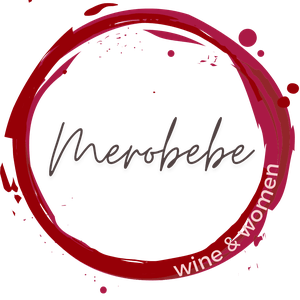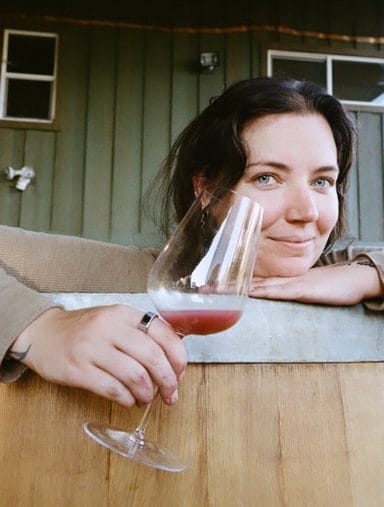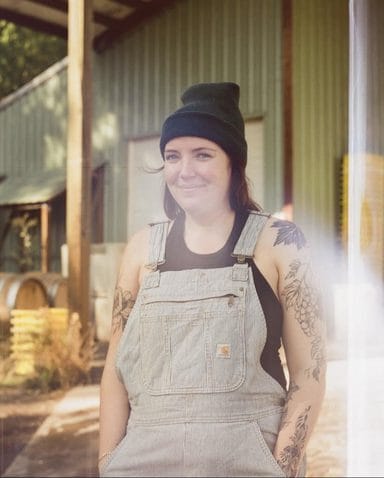
Happy Wine Wednesday!
Today, we’re drinking the up-and-coming varietal carignan, then chatting with sommelier Reilly Hughes about the importance of sustainability in winemaking and how women are ushering in natural wine. Plus, our vinotainment of the week involves actress and activist Emma Watson - but not in the way you might think!
Pour yourself a glass and let’s get our wine nerd on.

Carignan
Cheap, Delicious, and Misunderstood
Carignan (ka-ree-nyon) has historically had a reputation as being a cheap, low-quality wine but is actually a cheap, delicious wine. It’s just not as well-known as some other red wine grapes!
While originally from Spain, this varietal is most often found as a blending grape in French wine, although you can drink carignan around the world (from Algeria to Tunisia to Morocco to Israel to Chile to Portugal to South Africa – you get the idea.) Today, some of the best known productions can be found in southern France and Catalonia (the region in the north-east corner of Spain bordering France), and Sardinia in Italy.
One of the reasons this varietal is so popular with winemakers is because of its ability to produce very large yields with little water. In fact, it was actually the most widely planted grape in France in the 70’s and 80’s. Unfortunately, because wine producers received government aid based on their production at that time, billions of liters of low-quality carignan was churned out, giving the grape a bad rep.
Shortly after, the European Union began offering cash subsidies to vineyard owners in exchange for pulling out their vines in order to increase the quality (and price) of European wine. This caused most of the ‘low-quality’ carignan vines to be pulled out, and Merlot quickly surpassed it as the most widely planted grapevine in France.
Today, producers are starting to revitalize the wine and creating wonderful, high-quality carignans for all of us to enjoy!
And here comes the confusing part.
It’s very possible you’ve heard of or had carignan before, just under a different name. This grape is also known as carignane in the U.S., carignano, cariñena, cariyena, mazuelo/mazuela in Spain’s Rioja, bovale grande/bovale di Spagna in Italy’s Sardinia, and samsó in Catalonia.
To make things even more confusing, grapes that share synonyms but are not related to carignan include:
Carignan boushet
Bobal (a Spanish grape that’s also known as Carignan d’Espagne)
Auburn (a French grape also known as Carignan de Bedoin/de Bedouin/de Gigondas)
Alicante Bouschet (a French grape also known as Carignan jaune)
Grenache (which is also known as carignan rouge, carignane rosso, and carignane rousee)
Now that I’ve thoroughly confused you, let’s move onto what makes carignan (or whatever you want to call it…) great for drinking on its own and with food.
This wine was made for you if you love a lighter Zinfandel, Merlot, or even a Côtes du Rhône blend. In fact, it’s most commonly blended with Grenache, Mourvedre, and Syrah – the GSM blend that Côtes du Rhône is known for!
This medium-bodied red wine has less tannins (bitterness) than cabernet sauvignon, and bursts with red fruit flavors while being rich and smooth. It even has some cinnamon, licorice, and smoked meat notes for those who like a spicy wine (or drinking with a charcuterie board.) As a balanced, dry red without insane tannins, carignan is actually a perfect food pairing wine! Plus, as a medium-bodied wine, it can handle both lighter dishes and bolder ones.
Some food pairing ideas include richer poultry dishes (like duck, dark chicken meat, or Thanksgiving dinner), roasted pork, lamb, and beef brisket. Because of the spice notes, foods with cumin, coriander, dill, rosemary, thyme, oregano, soy sauce, and Za’atar will also pair perfectly!
Vegetarian? Carignan will pair perfectly with your butternut squash and pumpkin, eggplant, roasted red pepper, shiitake, and wild rice dishes.
As mentioned above, the smoked meat note also makes this the perfect charcuterie board pairing. In addition to smoked or cured meats, great cheese additions for this would be gouda and aged gouda, parmesan, manchego, and other mild sheep’s milk cheeses.
The best news about carignan?
You can get a high quality bottle in the $20 range, so stop by a local wine store to grab a bottle (or two) to try this weekend!
PS. It’ll also make for an affordable yet unique and delicious gift for the host of the next dinner party you go to.

Reilly Hughes
Sommelier
This interview has been edited for clarity.
Merobebe
If you could only drink one type of wine for the rest of your life, what would it be?
Reilly Hughes
I’d like to think I got interested or started drinking wine seriously when I lived in Spain, where I fell in love (hard) with Catalunya’s food and wine culture while living in Barcelona. So I have to say Carignan, which is in my opinion one of the best varieties in the Mediterranean – deep, scrubby, with beautiful black fruit, marked by soil. I could drink 80-year-old Carinyena everyday for the rest of my life. Easy.
Merobebe
What's your favorite wine and food pairing?
Reilly Hughes
Having recently moved back east, I am fully taking advantage of the cold Atlantic’s best time of year for shellfish and other seafood. Skate is one of the Northeast’s most sustainable fish options and its “wings” turn into a beautiful French-style dish if you roast or pan-fry it in a brown butter sauce with parsley and capers. Oysters and scallops aren’t off the table either. The range and diversity of white wines that can accompany these kinds of foods that are chilly and rich all at once are endless.
My go-to right now is probably… Stein’s dry Riesling. “Blauschiefer” Troken 2020. Its pure, fresh and driven with minerality, replete with pretty flowers and herbs and rocks, with no BS, no fancy styling. So much more complex than the Sauvignon Blanc and Sancerre competitors you’ll often find at this price point.

Merobebe
If you could have dinner with any wine industry figure, who would it be?
Reilly Hughes
Deirdre Heekin of La Garigista. Her project is out of Barnard, Vermont where she works with hybrid grapes, crosses between vinifera grapes and those of hardier Native American species. The vines are farmed biodynamically, a system that envisions the farm as a diverse ecosystem.
Part of her genius is to let the wine dictate what it’s going to become. The wines are fresh and rooted in the notion that wine is food and belongs on the table, like bread or fruit.
I always thought Vermont might seem too cold for good wine, the climate too daunting. But her wines are soulful and delicious and she has drawn attention to a part of the country that has scarcely been looked at before. She is most certainly a visionary in the natural wine movement and is usurping the pioneers to do what was once thought impossible and dispelled some entrenched myths about how and where good wine can be made in the United States.
Merobebe
What would be your wine superpower?
Reilly Hughes
Alcohol immunity. To either be immune to the effects of alcohol or tolerate “extreme” amounts of it without notable effects. Most importantly, the speed of recovery from insobriety… or maybe I just need to become a better “spitter.”
Merobebe
What first interested you in winemaking?
Reilly Hughes
I’m very passionate about sustainability and am always looking for ways to include it in everything I do. I come from a hospitality background, but have always been curious and interested in living closer to the origins of food and wine.
The wine industry is an agricultural industry and we rely immensely on nature and the people who help make and sell each bottle. Sustainability is key. I’m excited by the overall mindfulness of our industry when it comes to being stewards in this space — because it's only getting more important. The evolution of our collective consciousness is such a strong positive.
Merobebe
In your experience, do you think there are any biases or stereotypes that influence the way customers perceive or interact with female winemakers compared to male winemakers?
Reilly Hughes
I think there’s a misconception that it’s hard to get a seat at the table, but that’s changing. Throughout my career, I’ve been fortunate enough to have amazing support and mentorship from both male and female leaders. As I continue to grow in my career, I hope to be able to provide even more opportunities for the next generation of women leaders.
Merobebe
What challenges have you faced as a woman in winemaking?
Reilly Hughes
I think my biggest learning curve is communication style. I hate to generalize, but for women there is a fine line between pushy and push over. I’m blunt by nature, so I have had to refine that style over time. Sometimes I hold back too much that I appear under-confident. My communication skills are still a work in progress.
Merobebe
How do you think the wine industry can better support and promote diversity and inclusivity?
Reilly Hughes
“Industry Sessions'' is a project by Jirka Jierh and Jim Sligh, sommeliers and industry badasses. It is an incredible resource that serves to create welcoming spaces for BIPOC (black, indigenous, and people of color) wine industry professionals to share and learn together in community. The wine industry is not known for its racial diversity, but this initiative aims to do its part in addressing that disparity with a free online course. The course serves to leave behind the coded “somm-speak” in favor of clearer communication. This is a wonderful resource for anyone who aims for inclusivity in a hitherto exclusive world.
Merobebe
What advice do you have for other women who are interested in pursuing a career in the wine industry?
Reilly Hughes
Women are leading natural wine into the mainstream with more winemakers, bar owners, and estate founders, among other positions. We’re not just closing the gender-gap, but adding our own take on a market that has been mostly dominated by male tastes and sensibilities. New York based wine writer, Alice Feiring, opened the first natural wine bar in Paris in 1989 and after that, the wines made their way to New York. Some would call her the OG of the natural wine movement.
But natural wine is “at the tip of the iceberg” as more and more consumers, especially millennials, actively look for not only “healthier” solutions, but more distinct dining options. And seeing how women hold the power in the shopping aisle, they’re bound to hold the power on the creation side of it as well. It can certainly sometimes feel like the ‘traditional wine’ space is saturated but my hope for the future is that women will be placed in high positions and build support systems for one another; I think the exodus to natural wine will give women room of our own to flourish.
Merobebe
Tell us about your Instagram account, “Wine Funk.” What does funk mean? What makes a wine "funky"?
Reilly Hughes
Wine Funk was actually started by my best friend, Bridget O’Donnell, who introduced me to the world of natural wine years ago. We were quarantined together for much of 2020 and were drinking a lot of wine, so we decided to create a diary of sorts to catalog what we had been eating and drinking, which happened to be a lot of natural wine.

The word “funky” can mean many things and is certainly subjective. But whether an odor, or just something odd, it often conveys a sense of the unconventional. Technically speaking, the “funk” factor is associated with brettanomyces, or “brett,” a type of yeast found on everything from grapes to winery equipment, barrels, and even inside sealed bottles. A “little funky” to me means a pleasant amount of brett balanced by fruit, and I consider that a good thing. A lot ‘funky’ means the wine tastes like a stable full of not-so-fresh horses, for example.
However, when I hear the term used by a consumer, I always like to get a little information to figure out what the person is looking for or trying to avoid. Could be brett, a bit of kombucha-ness, a cider-y kick or even mousiness. Or maybe they’re just looking for something that’s not super fruity. Funky can often be overused as a general descriptor for natural wine in comparison to conventional wine, but we are really just drawn to wine’s non-fruit flavors and are trying to showcase wines outside of the pristine, fruit-forward that have become the standard.
Merobebe
You spent some months interning on a wine farm last year. What was the most surprising aspect of the winemaking process that you experienced?
Reilly Hughes
I spent a season at Hiyu Wine Farm, which is much more than a vineyard. Perhaps no place is as astonishing and unconventional — it is a deeply interwoven, interconnected, 30-acre farm tucked into Oregon’s Hood River Valley and the heart of the Columbia Gorge American Viticultural Area (AVA). The entire project is focused on biodiversity and sustainability. The result is wines being produced that are low-intervention and defy classification.
Learning under Nate Ready has been one of the greatest joys of my life. His approach to winemaking is esoteric but often historically inspired. The wines represent a fusion of passion, alchemy, and a little bit of mad science. Everything was surprising. Hiyu looks back to viticulture’s deep, Old World roots, where plants and animals – both domestic and wild – intermingled with farmers and their crops, creating a symbiosis where the produce of one could not be possible without the interplay and influence of the other.
It’s a living, breathing ecosystem, a healthy polyculture. The juice from multiple varieties blended, and no manipulation or additives in the cellar whatsoever. It's a very hands off approach. Yet, the wines can be simultaneously fresh and immediately accessible while delivering compelling nuance worthy of lengthy rumination.

Get a wine-related movie or book pairing for your weekend.
Today’s pairing is not a book or movie, but…
This Financial Times article on how Emma Watson (of Harry Potter fame) is now helping to run her brother’s unique gin company, Renais. The alcohol is made using grapes from Burgundy, France and is flavored in part by grand cru grape skins from Chablis in Burgundy. These discarded grape skins, from one of only seven grand cru vineyards in the area and one of the few that uses only organic farming methods, are only available for a 2-week window during the harvest season each year.

What’s your go-to wine?
Hit reply and let me know what your go-to wine is, whether it’s a special one for celebrations or your favorite $5 bottle from Trader Joe’s!
I’ll be sharing your responses in a future issue so we can all try your favorites.
Have a wine-derful week and see you next Wednesday!
Cheers,
Megumi
Have questions or feedback? Want to suggest a wine topic, woman in wine, or vinotainment pairing? Just reply to this email!




Copyright (C) " target="_blank">unsubscribe
